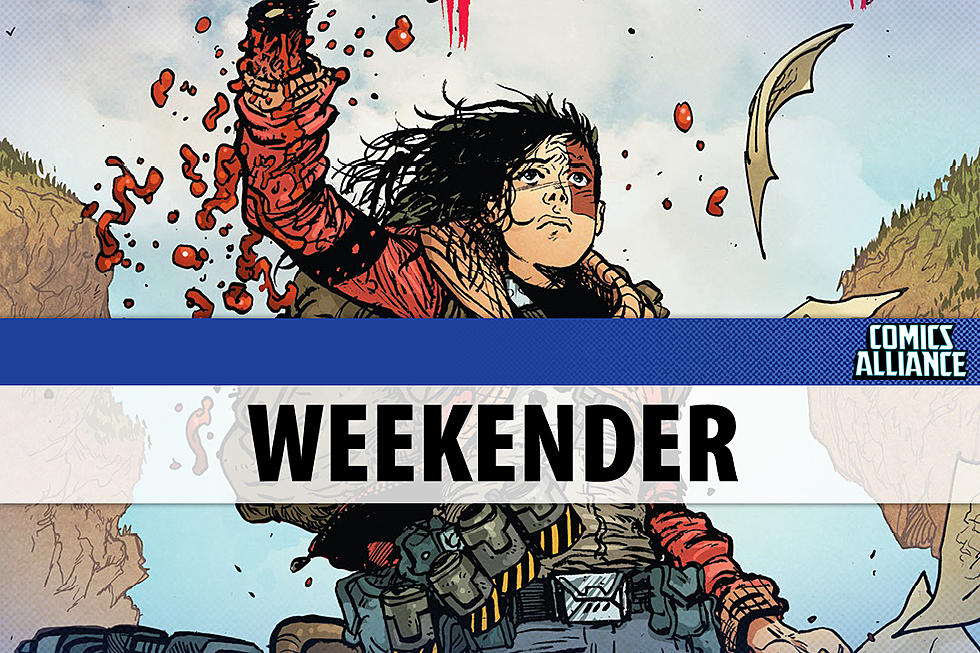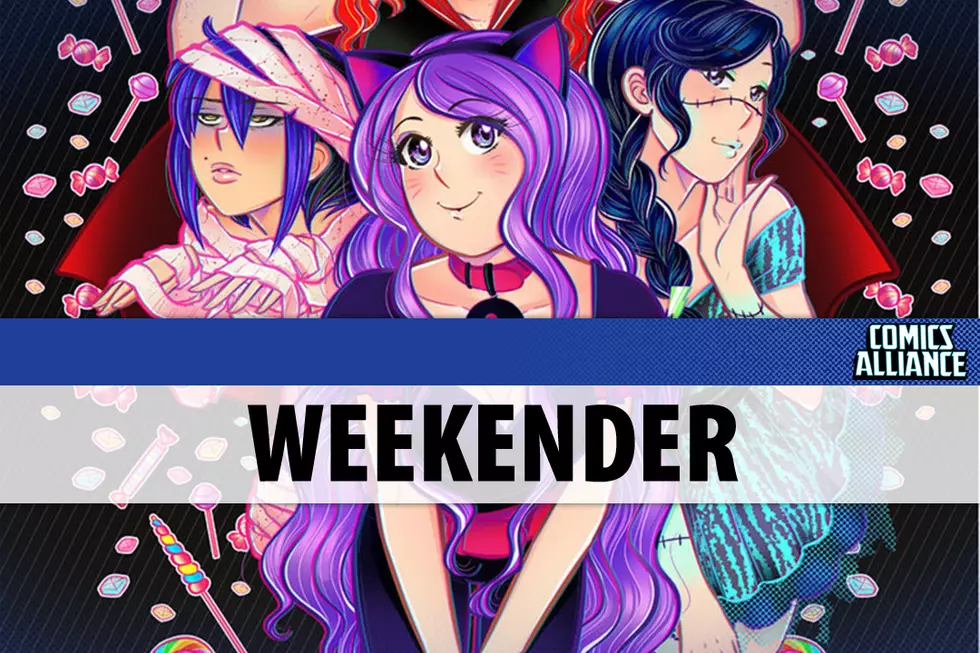![First Second’s Tenth Year: Editor Calista Brill On What Makes First Second Special [Interview]](http://townsquare.media/site/622/files/2016/04/firstsecond-brill-feat.jpg?w=630&h=420&zc=1&s=0&a=t&q=89&w=980&q=75)
First Second’s Tenth Year: Editor Calista Brill On What Makes First Second Special [Interview]
In 2006, First Second Books emerged as a fledging publisher with a distribution deal with Macmillan. Over the subsequent ten years the publisher has introduced American readers to international talents; promoted the work of new cartoonists to a wide audience; and produced some of the most talked-about books of recent years, including Laika,Boxers and Saints, The Sculptor and This One Summer.
All this week we've been speaking to some of the cartoonists associated with First Second about their last ten years in the industry, including Sara Varon, George O'Connor, and James Sturm. Today, however, we're talking to one of the architects of First Second's continued success, senior editor Calista Brill, about how she came to the company, what her job involves, and what it is that defines First Second.
ComicsAlliance: So what were you personally doing ten years ago, when First Second was first born? I understand that you weren’t with the publisher at its inception.
Calista Brill: I was working at the Walt Disney Company! Mostly I was editing children's books about Disney characters, but I found some space to work on my own graphic novel projects there --- notably, acquiring and editing Kean Soo's Jellaby graphic novels.
CA:Do you remember when you first heard of First Second, or what the first books from the publisher you encountered were? What were your initial thoughts about the line?
CB: I'm pretty sure I heard about First Second as soon as the imprint was created --- I was very interested in comics and graphic novel publishing, and I was keeping an ear to the ground to see what was going on at other publishing houses. I think that the first MoCCA [Museum of Comic and Cartoon Art] Art Fest I ever attended may have also been the first MoCCA that First Second ever exhibited at. I have a vague memory of talking to my now-colleague [marketing and publicity manager] Gina Gagliano, who was manning the booth, and asking her if First Second was by any chance hiring! (They were not.)
CA: When did you begin your professional relationship with First Second, and how did that come about…?
Brill: Soon after that MoCCA happened, I got to know Gina a little through a women in comics meet-up in New York City that we both attended. When an editorial position at First Second opened up, she mentioned it to me and I eagerly applied. That was in December 2007 or January 2008 -– sometime around then. Several rounds of interviews later with Mark Siegel (the editorial director and founder of the company), I was in! And I've never looked back.
CA: This will likely sound like a pretty silly question, but can you tell us a little bit about what you do as an editor, aside from the obvious (that is, “edit”). Of all the folks who work on comics, “editor” can be one of the more nebulous roles, at least in terms of what readers know or understand about it.
Brill: Yeah, it really is a bit of everything --- including the kitchen sink. The short version is, I do all the stuff a conventional editor does, but I also do art direction and a lot of project management. Graphic novels have so many moving parts --- way more than most conventional books --- and a graphic novel editor, at least one like me, is in charge of keeping all those moving parts moving!
My favorite part of my job, though, is the creative partnership I enjoy with the authors and artists I work with. There is a great pleasure in helping someone fulfill their creative vision–I get enormous satisfaction from that.
CA: In your time with First Second, have you developed a sense of what defines a First Second book as a First Second book? That is, are there works that you guys have published that other publishers might not have, or that you couldn’t imagine having not published?
Brill: Yes, absolutely --- but unfortunately it's sort of an "I know it when I see it" situation. In very broad terms, we don't publish much manga, or genre titles --- and by "genre" I mean superhero, crime, science fiction, that sort of thing. (Although of course there are always exceptions!) There are many other publishers who do that stuff so well --- it doesn't make sense to try to compete with them! Especially when we have our own thing going.
As for what we do publish, we tend to look for books that feel like they really mean something to the person who made them. We like books that feel as though the author had a deep personal stake in their making. Our list is sort of hilariously broad and diverse --- but if it has one unifying feature, that idiosyncratic, personal flavor is probably it.
CA: Where do you see First Second’s place in the world of comics at the point, both within the market and within the medium itself?
Brill: We occupy an interesting spot in the industry, because unlike many of our competitors we don't focus exclusively on one end of the market or another. We sell books very successfully into the bookstore market, the direct market, and the library market --- which is unusual.
As for the second half of that question, I don't think I'm equipped to answer it! I would be pretty curious to hear what other people thought, though.
CA: Are there typical First Second readers? Do you guys have a particular audience? And have you seen the audience expanding or changing in the last few years?
Brill: Our audience has been steadily expanding since we began publishing, which means that First Second has experienced steady growth since day one. A very happy state of affairs! As for what the typical First Second reader is, there probably is an answer --- certainly, we see a lot of comics-hungry families at conventions --- but in general I think it's hard to pin down. And that's probably good --- a healthy business has a very wide variety of customers.
CA: Are there typical First Second authors? Looking back at all of the First Second books I’ve read, I notice that there are plenty of authors whose work I saw for the very first time in a work from the publisher, and others who were already established creators who came to work with the publisher.
Brill: This question is even harder than the last! Probably not, is your answer. We make a point of trying to work with as wide a variety of people as we can!
CA: Do you feel like First Second has evolved as a publisher during your time there, or do you think it found its place quite quickly, and has stuck to it, expanding more than changing?
Brill: I think the story probably shows more consistency that it does change, but of course we have evolved --- I think we have figured out what the happy meeting point between our taste and our readers' taste is. We have fewer misfires and more hits with every year.
CA: I’ve been asking all of the First Second creators I’ve talked to if they had a favorite First Second book, but that’s probably less fair to ask an editor. Do you have any books you're most proud of?
Brill: Why, I love all my children equally!
I will say, although I didn't acquire this one myself --- Mark Siegel brought it in from France --- I put a lot of work in on our edition of The Photographer early in my career at first second. And I vividly remember at the moment I realized that I was working on a book that 1) I adored, and 2) I had serious expectations would change the world.
It was an incredible feeling --- still is!
CA: If a hypothetical comics reader were completely unfamiliar with First Second and wanted to know what kinds of books you published, what are some of the titles you might recommend to that hypothetical reader to get a sense of what First Second is all about...?
Brill: First Second publishes great graphic novels for every reader! Including: Nursery Rhyme Comics, Julia's House for Lost Creatures, The Nameless City, Battling Boy, Anya's Ghost, Relish, Sailor Twain, The Photographer, and Above the Dreamless Dead.
More From ComicsAlliance

![First Second’s Tenth Year: James Sturm’s Decade of Adventures in Cartooning [Interview]](http://townsquare.media/site/622/files/2016/04/sturm-feat.jpg?w=980&q=75)
![First Second’s Tenth Year: George O’Connor’s Journey from ‘Mohawk Country’ to Mount Olympus [Interview]](http://townsquare.media/site/622/files/2016/04/oconnor-feat1.jpg?w=980&q=75)
![First Second’s Tenth Year: Sara Varon Looks Back On Her Comics Decade [Interview]](http://townsquare.media/site/622/files/2016/03/saravaron.jpg?w=980&q=75)


![Colinet And Charretier Announce ‘The Infinite Loop Volume 2: Nothing But The Truth’ [Exclusive Interview]](http://townsquare.media/site/622/files/2017/03/Loop01.jpg?w=980&q=75)
![Five Stars: Starting At The End With Jeff Smith [Interview]](http://townsquare.media/site/622/files/2017/03/FiveStars-Smith.jpg?w=980&q=75)
![Take Me to Your Teacher: Trevor Mueller and Gabo Discuss ‘Albert the Alien’ [Webcomic Q&A]](http://townsquare.media/site/622/files/2017/03/0ALBERTVOL3_COVER_notitle-copy.jpg?w=980&q=75)
